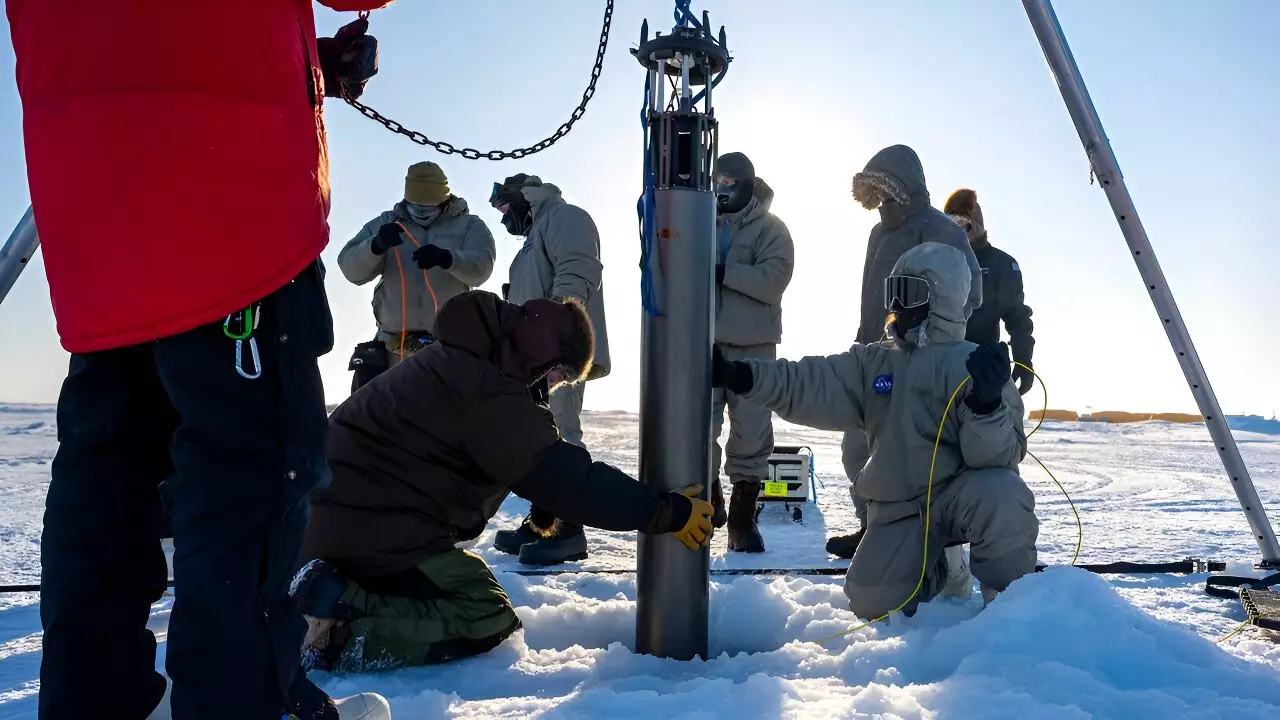The pursuit of knowledge about climate change and its far-reaching implications has spurred groundbreaking innovations in scientific research technologies. Among these endeavors is one that seeks to address a particularly critical problem: understanding how ice shelves in Antarctica are melting and their subsequent impact on rising sea levels. NASA’s IceNode project exemplifies efforts to conquer the harsh realities of remote and inhospitable environments while simultaneously pushing the boundaries of engineering.
In 2024, a team of engineers from NASA’s Jet Propulsion Laboratory (JPL) undertook a mission to advance IceNode technology by conducting tests in the frigid Beaufort Sea, north of Alaska. Targeting an area characterized by extreme cold and isolation, the team worked with a cylindrical robot designed to gather vital scientific data from beneath thick layers of sea ice. This experiment represents not just a technological feat but also a critical step in understanding the melting processes of ice shelves that, when fully melted, could increase global sea levels by an astounding 200 feet (approximately 60 meters).
Conducted during the U.S. Navy Arctic Submarine Laboratory’s Ice Camp operation—an initiative that provides a temporary base for experts to work in the Arctic—the test showcased the hurdles of operating in such extreme conditions. The environmental challenges encountered, including temperatures plummeting to minus 50 degrees Fahrenheit, provided an essential reality check that influenced both the robot’s design and mission objectives.
Ice shelves are vital components of the Earth’s cryosphere, functioning as barriers that prevent deeper ice sheets from surging into the ocean and contributing to rising sea levels. Consequently, scientists have a dual challenge: measuring the melt rates of these ice shelves and understanding their interaction with warmer ocean currents. Grounding zones—the irregular areas where floating ice meets land and ocean—are particularly difficult to study due to their inaccessibility. Traditional satellites cannot penetrate the thick layers of ice to reveal what lies beneath, making effective monitoring of these regions a daunting task.
IceNode aims to change that narrative. By deploying autonomous robots designed to navigate underneath ice shelves, researchers hope to capture data directly at the ice-ocean melting interface. The ultimate objective is to provide more accurate models for predicting sea level rise by gathering real-time data on how quickly warm ocean water circulates beneath ice sheets.
The conception of the IceNode robots speaks to the ingenuity required to address environmental challenges. These prototypes, measuring 8 feet in length and featuring a unique tri-legged “landing gear” system, rely on innovative software to facilitate autonomous navigation without propulsion. This design minimizes energy needs and allows the robots to drift along ocean currents, making them suitable for long-term underwater assessments.
Once in position, the robots can release ballast and secure themselves to the bottom of the ice, where they will conduct measurements of salinity, temperature, and water flow dynamics over an extended period. By operating for up to a year, these autonomous robots will accumulate invaluable seasonal data that could vastly improve climate models. As Paul Glick, the principal investigator for IceNode, notes, these robots serve as a low-cost yet effective means of bringing scientific instruments to the most challenging and poorly understood areas of our planet.
The early tests of IceNode have yielded encouraging results, paving the way for further prototypes and refined iterations of the technology. Engineers have tested previous models in diverse environments, from California’s ocean to the frozen lakes of the Midwest, each experience contributing insights relevant to the IceNode design. As the team gears up for subsequent Arctic tests, plans loom large for the future deployment of a complete fleet beneath Antarctic ice shelves.
The potential implications of the IceNode project extend far beyond academic curiosity. Understanding the dynamics of ice shelf melting is crucial for policymakers and communities that may face the consequences of rising sea levels in the near future. Ultimately, the data captured by these innovative robots will offer concrete insights into climate models, enabling more informed decisions regarding environmental strategies and risk assessments.
As climate change continues to provoke global challenges, initiatives like IceNode stand at the forefront of science and technology’s role in preserving our understanding of the natural world. The technological innovations derived from space exploration now have applications at the icy frontlines of climate change, illustrating how interdisciplinary approaches can drive progress.
The journey of IceNode is just beginning, but its promise lies not only in potential discoveries but also in enhancing our commitment to protecting the planet’s climate. Each piece of data collected is a step toward unraveling the mysteries of our rapidly changing environment, reinforcing the urgency of scientific inquiry and technological ingenuity in the face of global challenges.


Leave a Reply